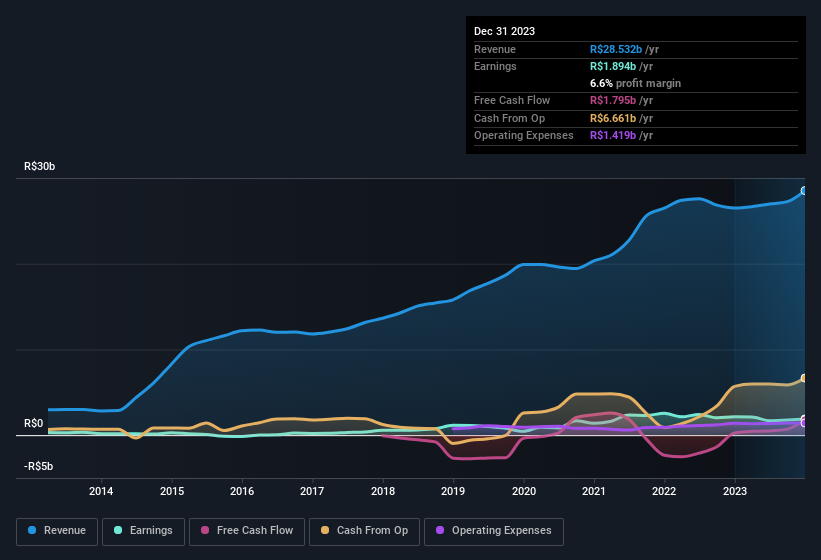- Brazil
- /
- Electric Utilities
- /
- BOVESPA:ENGI3
Earnings Troubles May Signal Larger Issues for Energisa (BVMF:ENGI3) Shareholders
Investors were disappointed by Energisa S.A.'s (BVMF:ENGI3 ) latest earnings release. We did some further digging and think they have a few more reasons to be concerned beyond the statutory profit.
See our latest analysis for Energisa

In order to understand the potential for per share returns, it is essential to consider how much a company is diluting shareholders. In fact, Energisa increased the number of shares on issue by 12% over the last twelve months by issuing new shares. As a result, its net income is now split between a greater number of shares. Per share metrics like EPS help us understand how much actual shareholders are benefitting from the company's profits, while the net income level gives us a better view of the company's absolute size. You can see a chart of Energisa's EPS by clicking here.
How Is Dilution Impacting Energisa's Earnings Per Share (EPS)?
Energisa has improved its profit over the last three years, with an annualized gain of 37% in that time. In comparison, earnings per share only gained 22% over the same period. Net profit actually dropped by 11% in the last year. But the EPS result was even worse, with the company recording a decline of 17%. Therefore, the dilution is having a noteworthy influence on shareholder returns.
In the long term, if Energisa's earnings per share can increase, then the share price should too. But on the other hand, we'd be far less excited to learn profit (but not EPS) was improving. For that reason, you could say that EPS is more important that net income in the long run, assuming the goal is to assess whether a company's share price might grow.
That might leave you wondering what analysts are forecasting in terms of future profitability. Luckily, you can click here to see an interactive graph depicting future profitability, based on their estimates.
Our Take On Energisa's Profit Performance
Energisa issued shares during the year, and that means its EPS performance lags its net income growth. Therefore, it seems possible to us that Energisa's true underlying earnings power is actually less than its statutory profit. But at least holders can take some solace from the 22% per annum growth in EPS for the last three. Of course, we've only just scratched the surface when it comes to analysing its earnings; one could also consider margins, forecast growth, and return on investment, among other factors. In light of this, if you'd like to do more analysis on the company, it's vital to be informed of the risks involved. Every company has risks, and we've spotted 3 warning signs for Energisa you should know about.
This note has only looked at a single factor that sheds light on the nature of Energisa's profit. But there are plenty of other ways to inform your opinion of a company. Some people consider a high return on equity to be a good sign of a quality business. So you may wish to see this free collection of companies boasting high return on equity, or this list of stocks that insiders are buying.
Valuation is complex, but we're here to simplify it.
Discover if Energisa might be undervalued or overvalued with our detailed analysis, featuring fair value estimates, potential risks, dividends, insider trades, and its financial condition.
Access Free AnalysisHave feedback on this article? Concerned about the content? Get in touch with us directly. Alternatively, email editorial-team (at) simplywallst.com.
This article by Simply Wall St is general in nature. We provide commentary based on historical data and analyst forecasts only using an unbiased methodology and our articles are not intended to be financial advice. It does not constitute a recommendation to buy or sell any stock, and does not take account of your objectives, or your financial situation. We aim to bring you long-term focused analysis driven by fundamental data. Note that our analysis may not factor in the latest price-sensitive company announcements or qualitative material. Simply Wall St has no position in any stocks mentioned.
About BOVESPA:ENGI3
Energisa
Through its subsidiaries, engages in the generation, transmission, and distribution of electricity in Brazil.
Solid track record with low risk.
Market Insights
Weekly Picks


Crazy Undervalued 42 Baggers Silver Play (Active & Running Mine)


Fiducian: Compliance Clouds or Value Opportunity?

Willamette Valley Vineyards (WVVI): Not-So-Great Value
Recently Updated Narratives

Watch Pulse Seismic Outperform with 13.6% Revenue Growth in the Coming Years

Significantly undervalued gold explorer in Timmins, finally getting traction

Moderation and Stabilisation: HOLD: Fair Price based on a 4-year Cycle is $12.08
Popular Narratives


MicroVision will explode future revenue by 380.37% with a vision towards success


NVDA: Expanding AI Demand Will Drive Major Data Center Investments Through 2026





